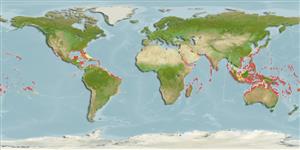Common names from other countries
Classification / Names / Names
Nomi Comuni | Sinonimi | Catalog of Fishes (gen., sp.) | ITIS | CoL | WoRMS
Environment: milieu / climate zone / depth range / distribution range
Ecologia
; distribuzione batimetrica 0 - 30 m (Ref. 107215). Tropical
Indo-Pacific and Western Central Atlantic.
Length at first maturity / Size / Peso / Age
Maturity: Lm ? range ? - ? cm Max length : 41.6 cm TL maschio/sesso non determinato; (Ref. 119316); Peso massimo pubblicato: 375.00 g (Ref. 119316)
Depth range based on Belize from Ref. 86832. Burrows in sand and is often associated with seagrass beds (Ref. 85218). This is a highly burrowing form. A fish is known to live inside the body (Ref. 118). Caribbean specimens eject Cuvierian tubules when disturbed (Ref. 85218). Deposit feeder (Ref. 833).
Life cycle and mating behavior
Maturità | Riproduzione | Deposizione | Uova | Fecundity | Larve
Members of the class Holothuroidea are gonochoric and have only one gonad. Spawning and fertilization are both external and some exhibit brooding. Life cycle: Embryos develop into planktotrophic larvae (auricularia) then into doliolaria (barrel-shaped stage) which later metamorphose into juvenile sea cucumbers.
James, D.B. 2001. (Ref. 118)
IUCN Red List Status (Ref. 130435)
CITES status (Ref. 108899)
Not Evaluated
Not Evaluated
Human uses
| FishSource |
Strumenti
Fonti Internet
Estimates based on models
Preferred temperature
(Ref.
115969): 25.2 - 29.2, mean 28 (based on 4333 cells).
Resilienza
Alto, tempo minimo di raddoppiamento della popolazione meno di 15 mesi (K=0.7).
Vulnerability
Low vulnerability (10 of 100).
Price category
Unknown.
